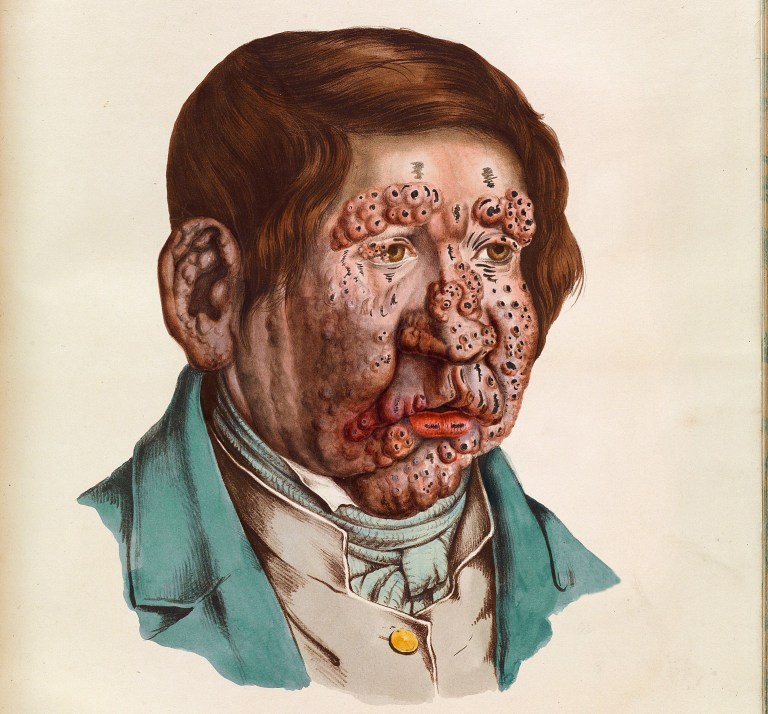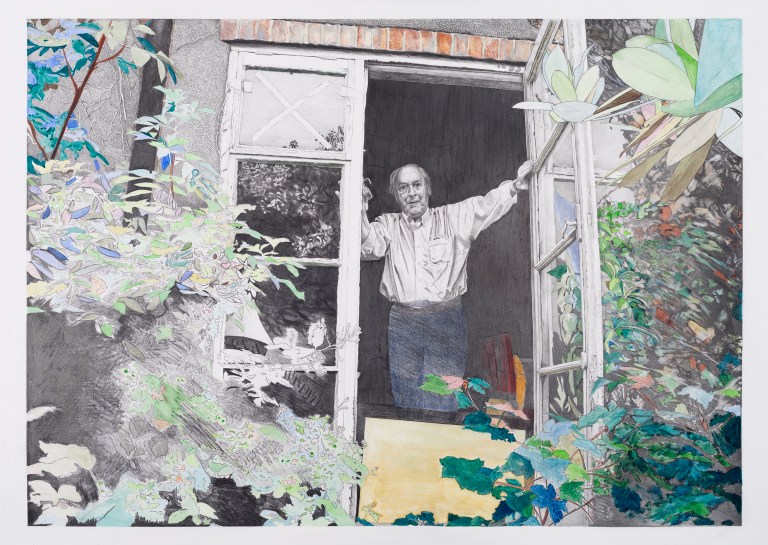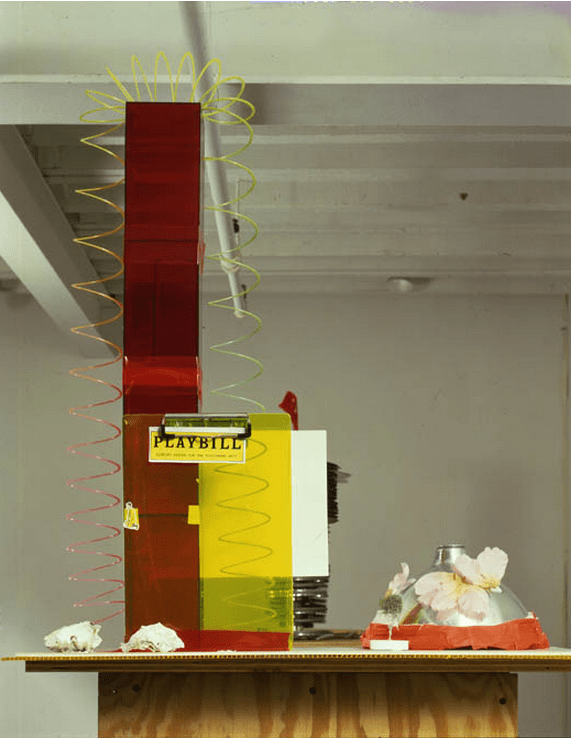Pipe Dreams: The Curious Case Of René Magritte
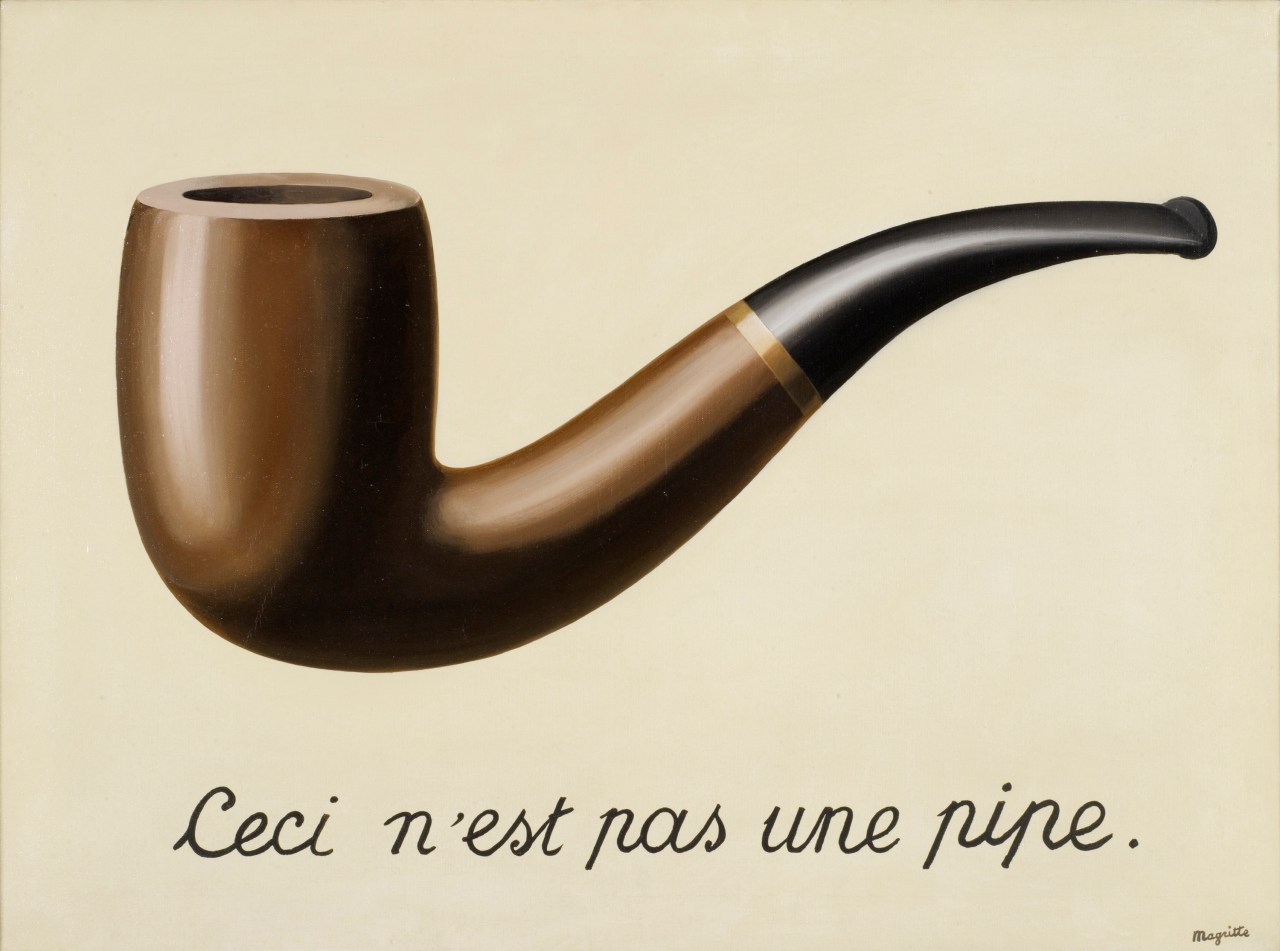
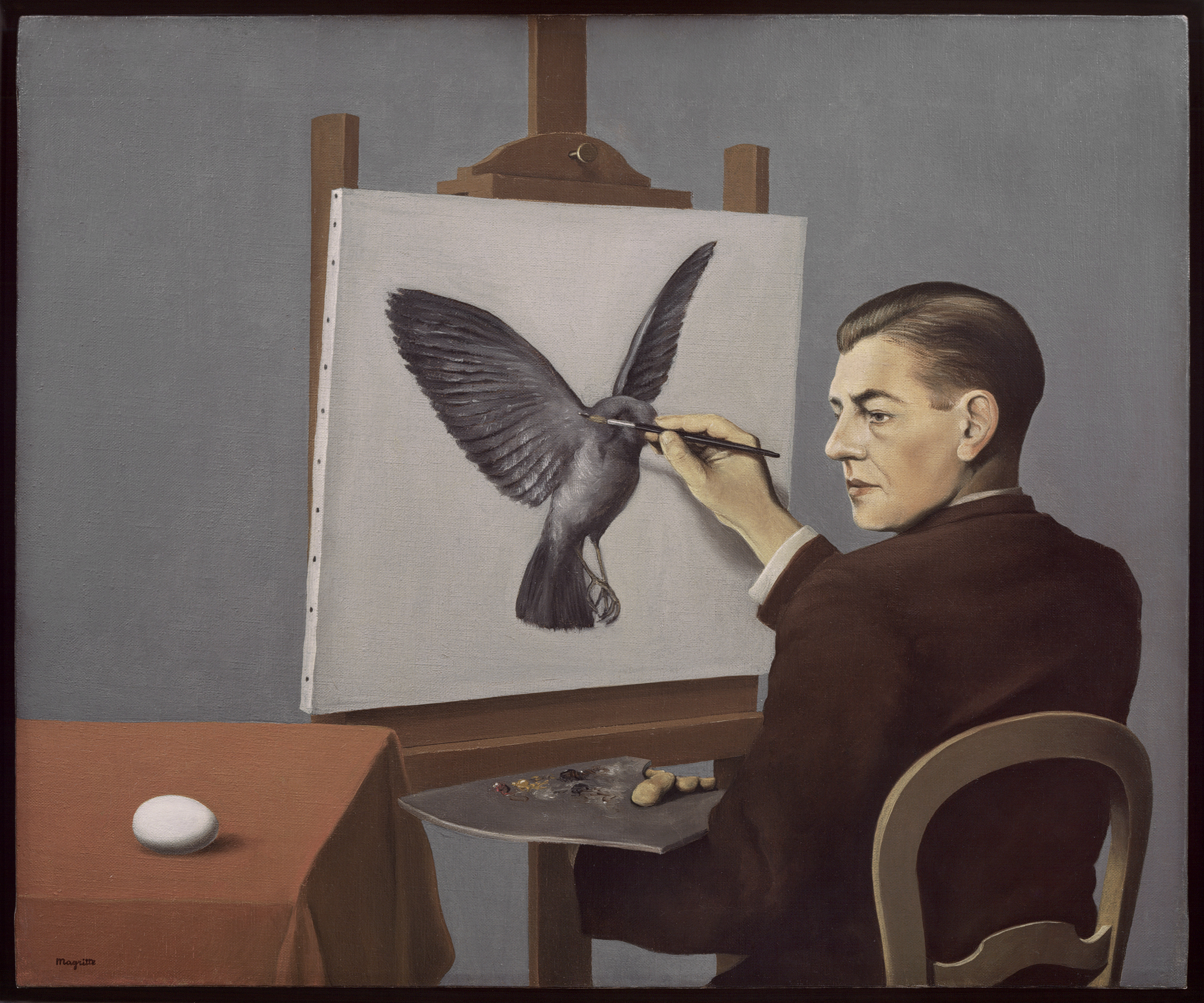
Wilbur Ross. © Charly Herscovici -– ADAGP – ARS, 2014. Courtesy the Menil Collection, Houston.
One night, in 1936, Magritte woke up. In the room where he was sleeping sat a birdcage with a bird in it, asleep. For whatever reason, his eye fell on it.
A magnificent error caused me to see an egg in the cage, instead of the bird. I then grasped a new and astonishing poetic secret, because the shock I experienced had been provoked precisely by the affinity of two objects, the cage and the egg, whereas previously I used to provoke this shock by bringing together objects that were unrelated. i
“Ever after that revelation,” he said, “I sought to discover if objects other than the cage could not likewise manifest—by bringing to light some element peculiar to them and rigorously predetermined—the same evident poetry that the conjunction of the egg and the cage had succeeded in producing.” ii
Magritte’s belief in “the hidden affinities between objects,” as the art historian Suzi Gablik put it, springs from the artist’s conviction that “the poetic image,” conjured with similes, metaphors, and other figures of speech, “has a reality of its own.”iii In the same way that poets spark flashes of illumination by rubbing concrete images together (a dissecting-table, a sewing-machine, and an umbrella, for example), Magritte manipulates the tumblers of the visible world—Clip-Art renderings of consumer goods, domestic interiors, lions and jockeys and lady equestrians—until, with a click, they align and the poetic dimension, previously invisible, is suddenly revealed.
Magritte devoted much of his artistic life to sleuthing out the “elective affinities,” as he called them, not, in the usual Surrealist fashion, between dissimilar species of objects, but between related objects. Related in what way? Therein lies The Mystery.
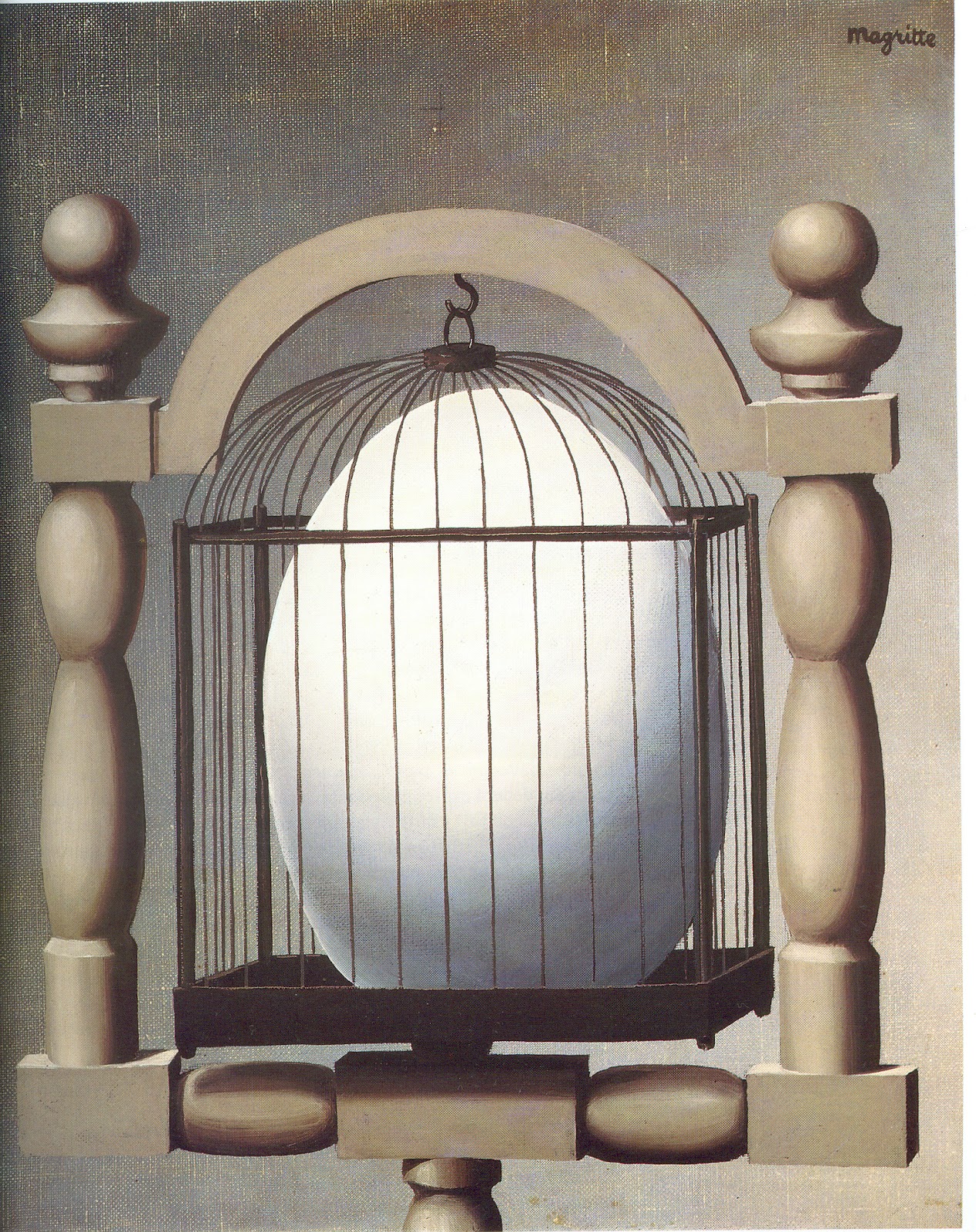
Elective Affinities (1933) marks the moment when Magritte stumbles onto the forensic methodology he’ll use, henceforth, to investigate the Enigma of the Everyday. The painting, which depicts an enormous egg in a birdcage, was inspired by his revelatory dream—the equivalent, for Magritte, of the chemist August Kekulé’s famous reverie, in which the image of a serpent devouring itself tail-first revealed the ring-shaped molecular structure of benzene.
From 1933 until his death in 1967, Magritte unriddled the riddle of a given object’s poetic twin, exploring the possibilities in a series of drawings until trial and error produced the answer. Not an answer, the answer. “This element to be discovered, this thing among all others obscurely attached to each object, suddenly came to me in the course of my investigations, and I realized that I had always known it beforehand, but that the knowledge of it was as if lost in the recesses of my mind,” he explained. “Since this research could yield only one exact response for each object, my investigations resembled the pursuit of the solution to a problem for which I had three data: the object, the thing connected with it in the shadow of my consciousness, and the light wherein that thing would become apparent.” iv
Magritte’s use of the term “investigations” is revealing. The method he used to solve his “problems,” as he called them, is a Surrealist’s idea of CSI, a combination of free association, semiotic codebreaking, and Hegelian dialectic. Bridging dream logic and what might be called visual reasoning, Magritte’s approach crosses Hegel with Lautréamont with automatic drawing, resolving thesis and antithesis in a startling, poetic synthesis of images.
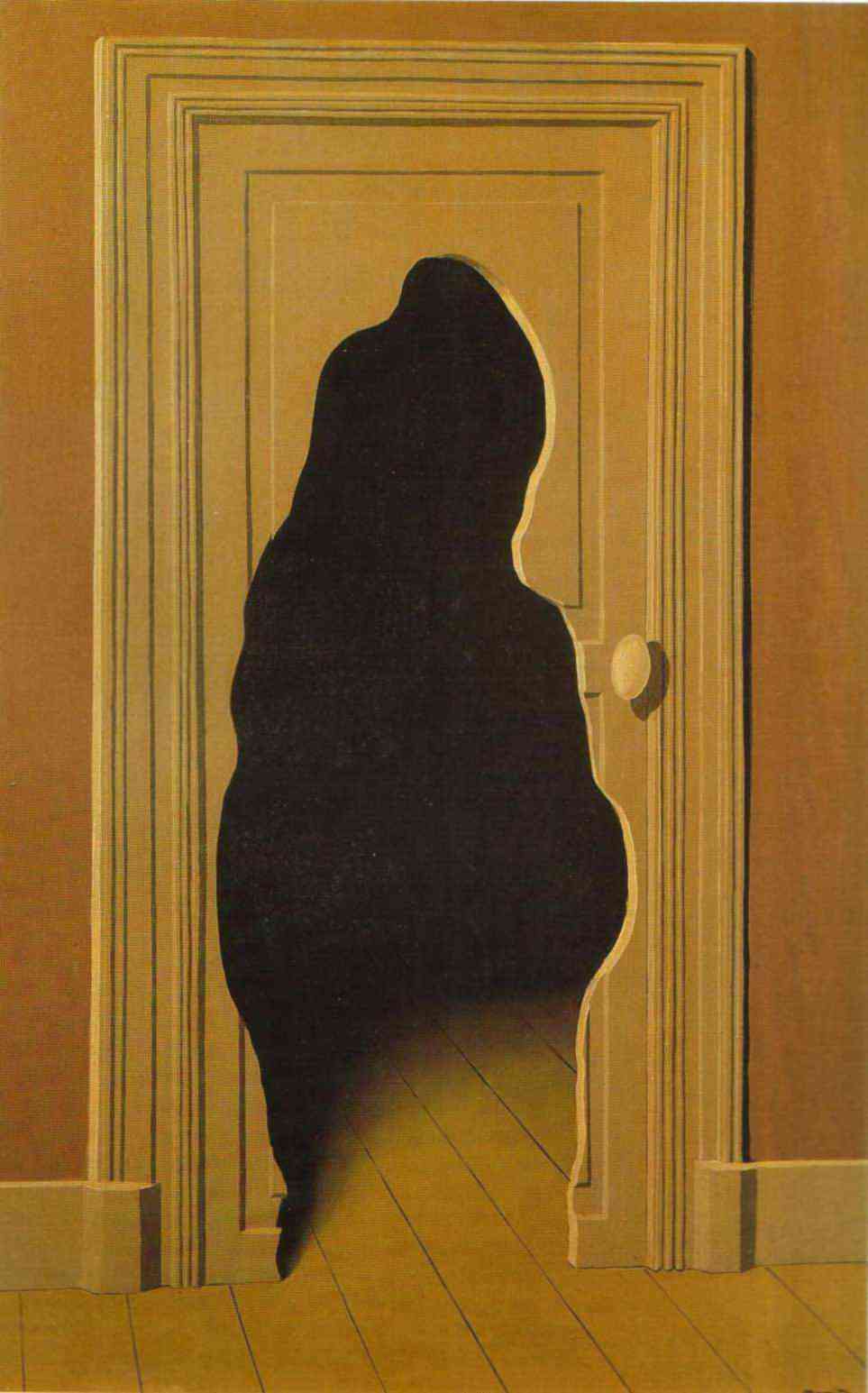
Case in point: The Problem of The Door. Solution:Unexpected Answer (1933), a door with an irregular shape cut out of it. Roughly the size of a hunched figure, the hole reveals a darkened room. We feel a prickling on the back of our necks, possibly because its undulating outline reminds us of the shrouded ghosts of gothic horror, or maybe because there’s just enough light falling across the threshold to pique our curiosity, tempting us to step into the unknown. “The problem of the door called for a hole one could pass through,” Magritte explained. v But how to solve this problem without recourse to the boring expedient of simply opening the door, which is, after all, what every closed door wants? “Let us make a hole in the wall beside the door panel, a hole that is also a door panel, a hole that is also an exit—a door.” On second thought, he can do better: “Let us further improve this juxtaposition by reducing the two objects to one: the hole goes quite naturally into the door panel. And through this hole we see darkness; this last image seems to be enhanced yet again if we light up the invisible thing hidden by the darkness, for our gaze always wants to go further and to see at last the object, the reason for our existence.” vi It’s the door that makes the mystery, and Magritte’s door, with its peep-show view of a room full of shadow, is even more mysterious than a closed door. Which is spookier, the closed door to Room 237, the chamber of nightmares in Stanley Kubrick’s The Shining, or the same door ajar, key dangling jauntily, daring us to step inside for a little visit? In fact, Magritte’s door is more uncanny than either, since it combines the enigma of a closed door with the eeriness of one that opens into darkness, ominously beckoning.
Magritte’s harness bells and balusters and tubas in flames aren’t much help to sleuths on the trail of hidden meanings, because, as Magritte was at pains to point out, they don’t stand for anything, personal or political, Freudian or Jungian. Just the opposite: they stand outside the symbolic order, demanding that we forget everything we thought we knew about them.
The critics and the press couldn’t resist typecasting Magritte as a detective; his cryptic imagery made the stereotype irresistible, as did the fact that he, like Hercule Poirot, was a short, dapper Belgian. Then, too, his name recalls George Simenon’s Inspector Maigret (of whom the painter was fond, precisely because of the similarity of their names). Also like Maigret—and, not incidentally, Sherlock Holmes—Magritte was inseparable, in the public mind, from “the famous pipe,” as he put it. And, like Poirot, the Magritte Man in his paintings wore a derby. With his ad man’s appreciation of the power of personal branding, Magritte wasn’t above playing to his public; it wasn’t long before he was affecting, in real life, the bowler hat worn by his mysterious alter ego.
As it happens, there’s some truth to the Inspector Magritte caricature. Born in 1898, he nurtured fantasies, as a boy, of becoming a detective, a predictable dream at a time when boys throughout Francophone Europe thrilled to the exploits of dime-novel crimestoppers like Nick Carter and Nat Pinkerton (“The King of the Detectives”), as well as the Robin-Hood thievery of the gentleman burglar Arsène Lupin, chronicled in the French silent films of the day.
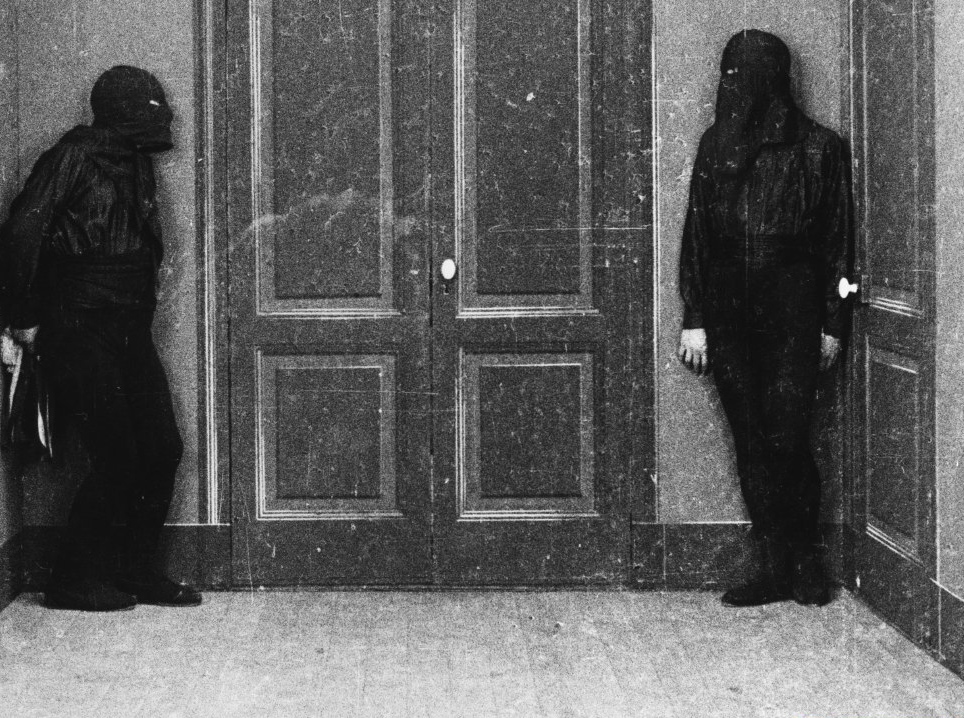
Magritte was 14 when the uncanny super-criminal Fantômas crept into European nightmares, in his black hood and cat suit, in Louis Feuillade’s 1913 silent, Fantômas. The Surrealists adored the arch-villain, who dispatched his bourgeois victims with endless inventiveness, and who seemed to take an anarchic delight in terror for terror’s sake. But Magritte was especially taken with the Lord of Terror, whose twisted genius made him a kind of morally depraved Sherlock Holmes. He referenced the Fantômas films in a number of works, most notably The Menaced Assassin(1926), a penny-dreadful tableau depicting bowler-hatted men closing in on a sex murderer; the painting borrows liberally from a scene in The Murderous Corpse. He painted a fannish portrait of Fantômas in a top hat and domino mask, Le Barbare [“The Savage”] (1927), and had a photo taken of himself beside it in his trademark derby, striking the same pose as the painted villain. He even tried his hand at fan fiction; in one of his sketches, Inspector Juve, Fantômas’s staunch adversary, realizes that the only way to defeat the sociopathic genius, once and for all, is to “get into one of Fantômas’s dreams…[to] try to take part as one of its characters”—a solution worthy of a Surrealist sleuth. vii

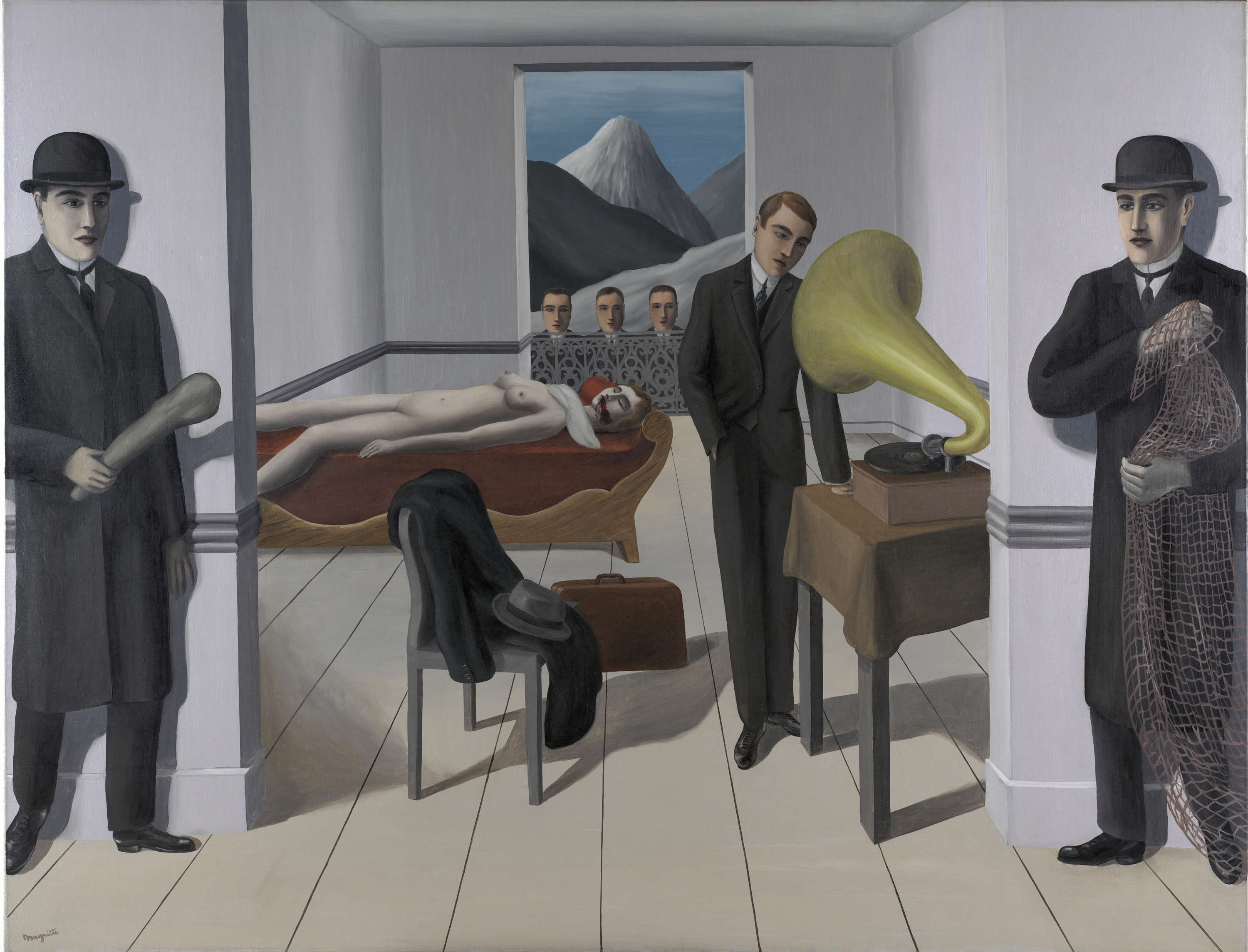
of Modern Art, New York. Kay Sage Tanguy Fund. © Charly Herscovici –
ADAGP – ARS, 2014.
Magritte himself was something of a mystery—a walking paradox, in many ways. Despite being synonymous, in the public mind, with Surrealism, he was notoriously hostile to Freudian readings of his work—in fact, to symbolic analysis of any sort; to those who claimed to have unlocked the meaning of one of his paintings, he was quick with the zinger, “You are more fortunate than I am.” viii
Even so, his childhood, like any childhood, is a mother lode for Freudian critics, and some of his themes and motifs are rich in analytic gold. Think, for example, of all the obscured faces in his work, many of them shrouded. (I’m thinking of The Lovers[1928], his creepy, almost necrophilic painting of a kissing couple whose heads are swaddled in white cloth.) What are we to make of those hidden faces in light of the disconcerting detail that his mother committed suicide by walking out of the house in the dead of night and throwing herself in a nearby river, from whence they fished her with her nightgown wrapped around her face? “It was never known whether she had covered her eyes with it so as not to see the death she had chosen,” writes Gablik, “or whether she had been veiled in that way by the swirling currents.” ix Another account adds the Freudian detail that the 14-year-old Magritte and his brothers found their mother’s nearly naked corpse, her sodden nightgown clinging to her skin—like the nightdress with breasts in Philosophy in the Boudoir (1947), we can’t help thinking. Magritte’s close friend Louis Scutenaire was convinced that the death of Magritte’s mother, which for official purposes remained unsolved, was the source of “the sensation of mystery” the artist carried with him for the rest of his life. x
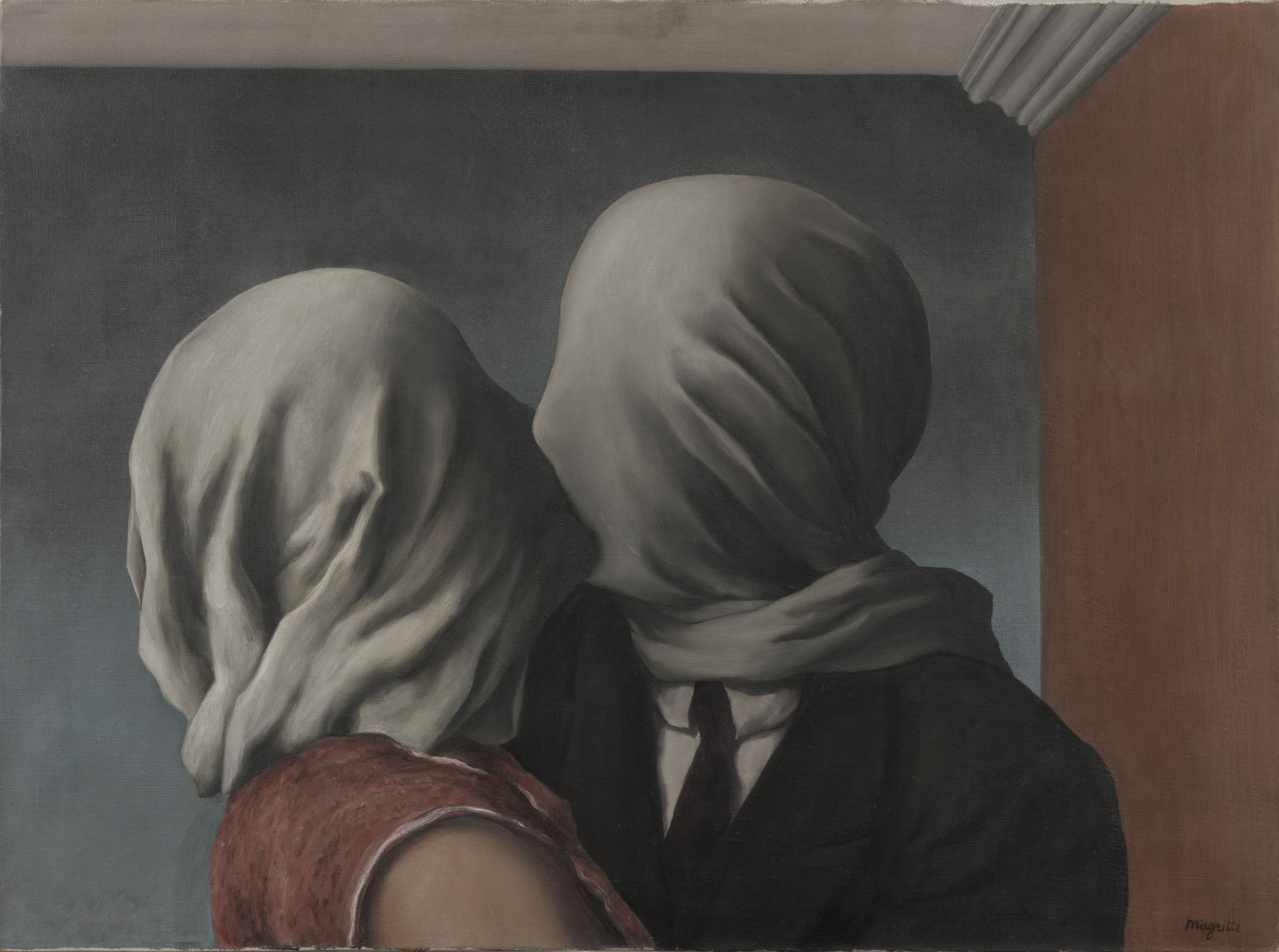
New York. Gift of Richard S. Zeisler. © Charly Herscovici -– ADAGP – ARS, 2014.
Another paradox: for a man who once announced, in a rare moment of fist-pounding radicalism, that his art was “only valid insofar as it resists bourgeois ideology, in the name of which life is extinguished”—he was briefly a member of the Belgian Communist Party in 1945, and leaned left for the rest of his life—Magritte was indistinguishable, in his sober attire and imperturbable routine, from the average Belgian banker. xi He may have imagined himself a “secret agent” for the Surrealist cause, operating behind enemy lines in bourgeois disguise, but if so, he was a mole whose cover was so deep even he didn’t know where his secret self began and his assumed identity left off. xii
Like the nondescript private investigator whose humdrum day Magritte chronicled in his fan-fiction vignette, “Nat Pinkerton”—a detective story devoid of mystery—he lived a life that looked, from the outside, almost self-parodically bourgeois: he dressed like a businessman, even at the easel, and was “meticulous in all things,” according to his friend Harry Torczyner: “Each day had its schedule.” xiii He was neat as a pin, scrupulously punctual, shrank from physical contact, abhorred familiarities, and shuddered at the thought of travel; his daily walk with his Pomeranian, Loulou, was adventure enough, thank you. Many of his paintings crackled with the static electricity of a barely suppressed eroticism, but all of the Venus de Milo nudes in his paintings were modeled by his wife Georgette, a household deity whom he worshipped devoutly—a passion that for most self-respecting Surrealists would have crossed the line into uxoriousness. Then again, domesticity taken to extremes may be its own kind of radicalism. As the cultural critic Rick Poynor quipped, on the subject of Magritte’s indiscreet ardor for his wife, “Conjugal eroticism: the contemporary love that dare not speak its name.” xiv
The Belgian-American essayist Luc Sante draws on his own heritage to make sense of the painter as “exemplifying the essence of Belgianness,” defined by Sante as an unimprovably bourgeois beige-ness, which is what makes the painter so effective as an undercover agent: the George Smiley of Surrealism. xv Sante talks, in his memoir The Factory of Facts, about the grayness of the Belgian sky, which he sees reflected in Magritte’s work in the ‘50s, during the period one wit dubbed the painter’s Stone Age, “when he painted a world made entirely of gray stone—figures, background, and sky. Magritte’s grisaille is less fantastic than observed, a true record of Belgian air.”xvi For Sante, Magritte is a visionary of boredom, “the murderous boredom of the civil servant at home, reading the obituary notices in his club chair, an antimacassar on each of its arms and one on the head rest, bowler on the hat rack…” xvii
True to form, Magritte lived in the regulation petit-bourgeois style, in a home furnished with comfy sofas and the obligatory baby grand piano and “department-store antiques,” as one writer who knew him put it. xviii Then again, this is the man who, pottering about in his dining-room studio, painted horrors like The Rape(1934), a Freudian bad trip in which a woman’s eyes have turned into breasts, her nose into a navel, her mouth into a vulva (discreetly hidden behind a neatly trimmed but luxuriant triangle of hair, unimaginable in our age of porno chic, where the fashionable mons is worn bald).
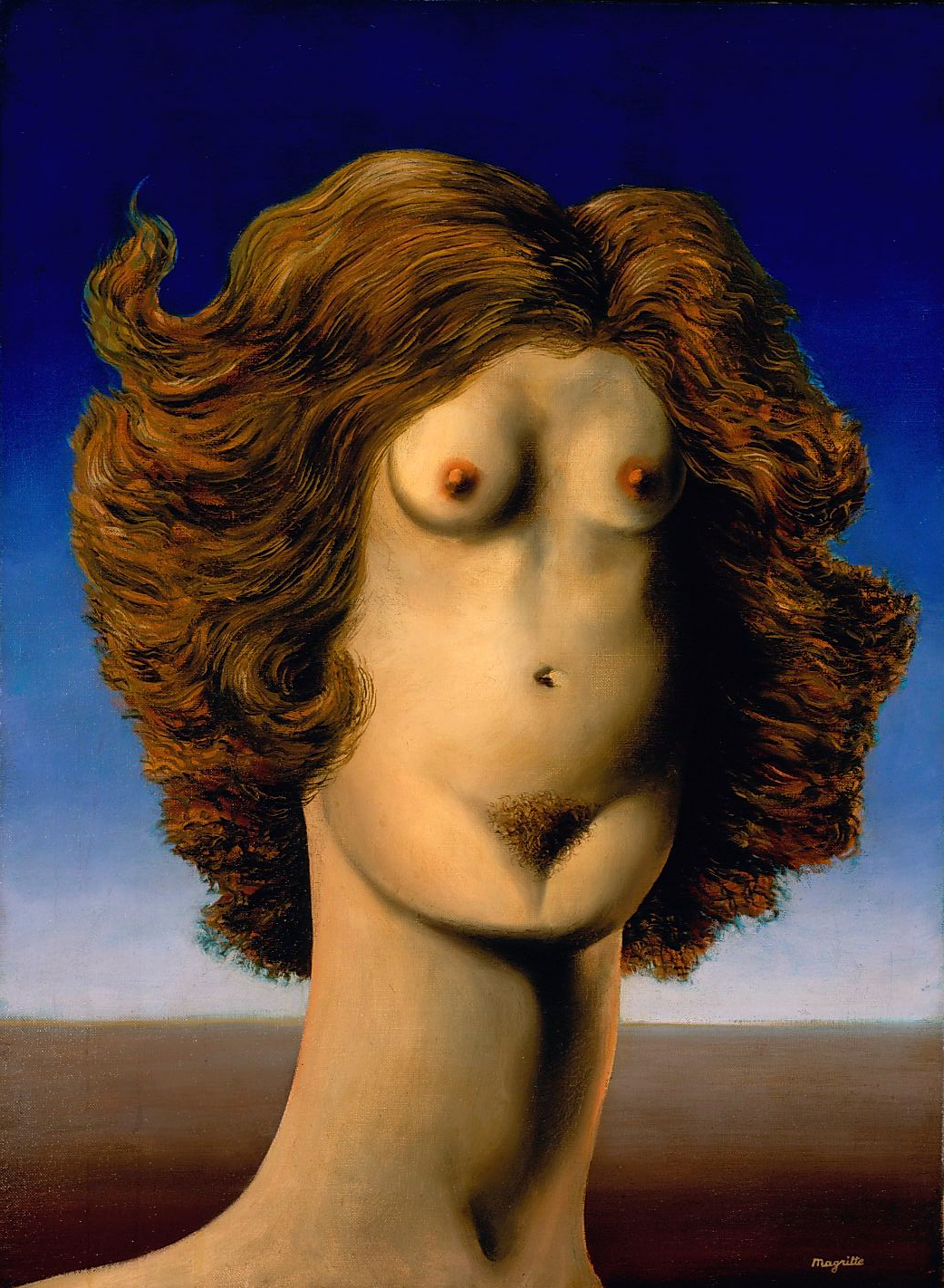
Magritte, who relished paradoxes, puns, and practical jokes, portrayed himself, in one of his few self-portraits, as The Magician (1952), mesmerizing us with his sleight of hand. Is it so hard to wrap our minds around the proposition that he was at once a pure product of the petite bourgeoisie and, at the same time,a deadpan trickster playing that role just a little too broadly? The dichotomy between the buttoned-down exterior and the mind that dreamed of making “everyday objects shriek out loud” brings to mind the classic Flaubert quote, “Be methodical in your life and as ordinary as a bourgeois, so that you can be violent and original in your work.” xix
Flaubert’s useful advice that always makes me think of William S. Burroughs in his conservatively tailored suits (“banker drag,” he called his look) or Paul Bowles, impeccably turned out in the lunar desolation of the Sahara, cigarette holder clamped in one corner of his wry smile, his chauffeured car laboring under the weight of several steamer trunks’ worth of wardrobe because one always dresses for dinner, even at some decrepit hotel beached, by a receding empire, in the Grand Erg Oriental.
Burroughs and Bowles were nothing if not transgressive, and their ironic affectation of the uniform of respectability, the suit, was an outward manifestation of a writing style whose hard-eyed precision made the depravity of their subject matter more existentially unnerving by contrast, not less—precisely the stylistic strategy employed by Magritte in his art. Burroughs, especially, made innocuousness more disquieting than in-your-face outrageousness: a dim, flickering presence given form by his suit, like H.G. Wells’s Invisible Man, his gaunt features shadowed by his fedora, Burroughs specialized in an anonymity so concealing it inspired the street boys of Tangier, where he lived in the ‘50s, to dub him el hombre invisible. In the pages of his novels, though, he was Nova Inspector Bill Lee, a hardboiled gumshoe on the trail of interstellar horrors too monstrous to mention.
Magritte, in like fashion, was quietly disquieting. While Dali was parading his coprophilia for all to see and be scandalized by, the unassuming Maigret of Belgian Surrealism was discreetly sawing through the philosophical props that hold up our assumptions about language, phenomenology, reality itself. Dali, behind closed doors, didn’t live up to his press; female fans hoping for a night of Sadean depravity were told to wait while the Disney of the Paraphilias fried a couple of eggs, after which he draped them ceremonially over the willing young lady’s shoulders, then showed her, without comment, to the door. xx Magritte, by contrast, delivers the goods. Casting his flashlight beam into the enigma of the ordinary, he directs our attention to mysteries hidden in plain sight—most notably, the stealthy murder of the real, and its diabolical impersonation by its uncanny double, representation.
Still, casting Magritte in the role of a detective doesn’t quite do the job we want it to do; calling him a philosophical investigator would be more like it. Titles like The Philosophical Lamp (1936) and In Praise of Dialectics (1937) betrayed his abiding interest in philosophy, as did his reading, which like any autodidact’s, was peripatetic, but serious nonetheless: Zeno, Nietzsche, Spinoza, Euclid, Bergson, Pascal, Heraclitus, Heidegger, Hegel, Sartre, Marx, Foucault. The boy who never outgrew Fantômas lived inside the same skin as the man who wrote Foucault fan mail. (Foucault returned the favor by writing an illuminating essay on the painter, This is Not a Pipe. Which has the sound of a covert operation: the saboteur of the Order of Things conspiring with the sworn foe of the Treachery of Images.)
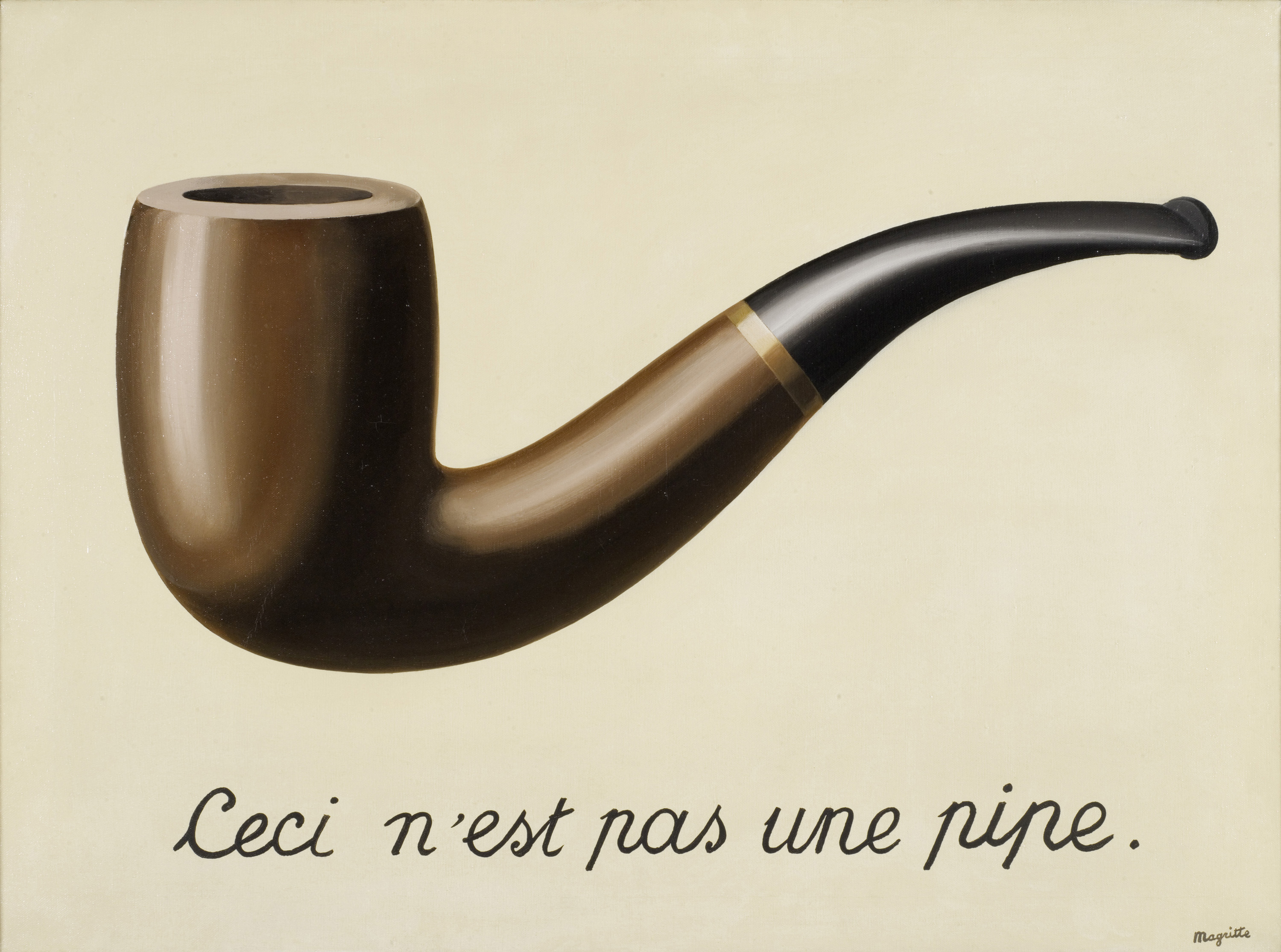
In the end, Magritte’s investigations take him to places where phenomenology borders on metaphysics—not so surprising for a painter who caught his first glimpse of the Mystery in the late-afternoon shadow of De Chirico. Locating an object’s lost twin only happened, he said, in “the moment of lucidity that no method can bring forth,” when the artist was fully attentive to the Mystery, a state of mind that sounds a lot like Zen “mindfulness” or that meditative “openness to the mystery” Heidegger called “releasement.” Magritte wrote,
Only the power of thought exists at this time. [W]e do not count for anything, but are limited to witnessing the manifestation of thought. When I say “I thought of joining, etc. …,” exactitude demands that I say “presence of mind exerted itself and showed me how the image…should be shown so that this presence of mind would be apparent.” xxi
Magritte’s paintings are mystery stories, albeit mystery stories in which the detective’s job, paradoxically, is to deepen the Mystery, not dispel it.
He was vehemently opposed to the reduction of the Irreducible Mystery of things to a pat interpretation; this was the bourgeois mind at work, he thought, clinging to its existential security blanket. “People who look for symbolic meanings fail to grasp the inherent poetry and mystery of the image,” he said. “No doubt they sense this mystery, but they wish to get rid of it. They are afraid.” Such minds “want something secure to hang onto, so they can save themselves from the void.” xxii
Embrace the mystery, he counsels. “The mind loves the unknown. It loves images whose meanings are unknown, since the meaning of the mind itself is unknown. The mind doesn’t understand its own raison d’etre, and without understanding that (or why it knows what it knows), the problems it poses have no raison d’etre either.” xxiii
Here, without warning, Magritte changes from the Fantômas of Existentialism, confirming the bourgeoisie’s night terrors, into a kind of Surrealist Taoist: an Alan Watts who stepped through the opening in the closed door, into the darkened room, only to discover it wasn’t dark after all.
Daily Meditation: When, by some magnificent error, you see an egg in the birdcage where the bird should be, recognize it for what it is: a glimpse of the hidden lives objects lead when freed from the domestic settings, utilitarian purposes, and cultural meanings we assign them. Imagine, for a moment, that your pipe is not a pipe, neither the “smoking utensil” (as my Random House calls it) clamped in your teeth nor its representation—the word “pipe,” the sound “pīp,” the letters P-I-P-E, a realistic painting of a pipe—but rather a thing that, stripped of all our associations, becomes suddenly, disorientingly other: irreducible in its thing-ness yet not what it appears to be either, because, cut loose from the human frame of reference, things can’t “appear to be” anything, other than unnamable, inscrutable, alien. They vibrate with what the essayist Nicholson Baker calls an “object’s primordial sense of strangeness.” xxiv The trick is to internalize this insight; to use the moment when you see an egg in the cage where the bird should be as a hole in a shut door. Step through it, into the world outside the symbolic realm. Life is a mystery story; our assignment, as private investigators, is to deepen the mystery, not dispel it. Cast the flashlight beam of your poetic intuition into the Enigma of the Everyday, illuminating the mysteries hidden in plain sight.
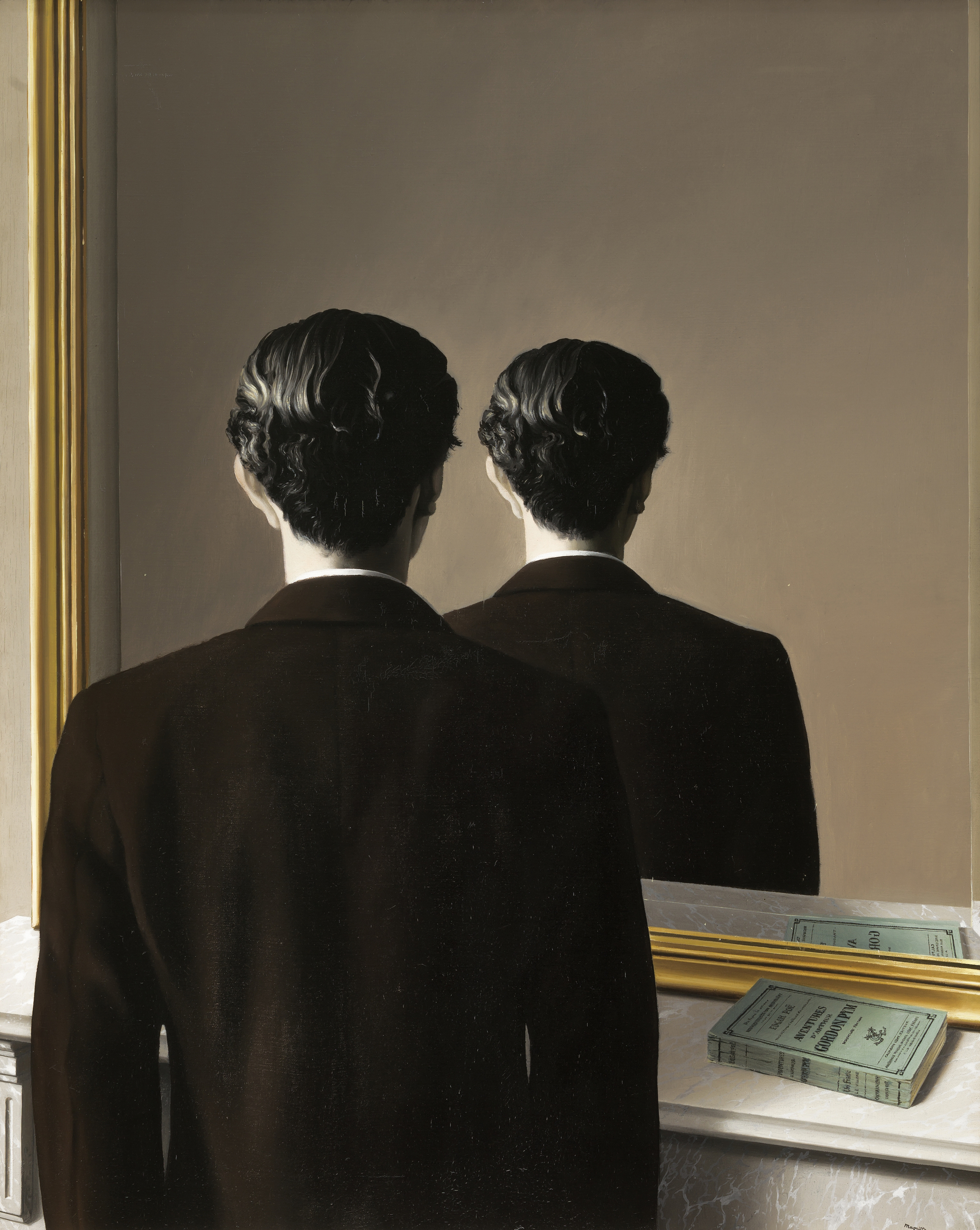
Museum Boijmans van Beuningen, Rotterdam. © Charly Herscovici -– ADAGP – ARS, 2014. Photograph: Studio Tromp, Rotterdam.
Endnotes
i#Quotedin Suzi Gablik, Magritte (London: Thames & Hudson, 1985), 101.
ii# Gablik, Magritte, ibid.
iii# Jacques Meuris, Magritte (Cologne: Taschen, 2007), 112.
iv# Ibid.
v# Meuris, 156.
vi# “Let us further improve”: http://www.mattesonart.com/1931-1942-brussels–pre-war-years.aspx.
vii# “Get into one of Fantômas’s dreams”: http://www.fantomas-lives.com/fanto51.htm.
viii# Gablik, 9.
ix# Gablik, 19. Magritte biographer David Sylvester disputes this account of events, enshrined in Magritte myth by the artist’s friend Scutenaire in his 1948 biography of the artist. Meuris, in his biography, writes, “There is no likely confirmation of this story; according to Irène Hamoir, Magritte never mentioned it in the presence of his friends, and evaded the questions on the subject asked by Louis Scutenaire when the latter was writing his account.” Meuris, Magritte, 12-13. Of course, evasiveness isn’t refutation. The events surrounding Magritte’s mother’s death may be fated to remain A Mystery, appropriately enough.
x# Meuris, 13.
xi# René Magritte, ‘Réponse à l’enquête SUR LA CRISE DE LA PEINTURE’ (1935), in René Magritte, ed. André Blavier (Paris: Flammarion, 2001), 85.
xiii# Harry Torczyner, Magritte: The True Art of Painting (Abradale, 1985), 12.
xiv# Rick Poynor, e-mail to the author, January 17, 2014.
xv# Luc Sante, The Factory of Facts (London: Granta Books, 1999), 160.
xvi# Sante, The Factory of Facts, 159.
xvii# Sante, 160.
xviii# Gablik, 154.
xix# “Shriek out loud”: http://press.moma.org/2012/03/rene-magritte-1926-1938/.
xx# Luis Bunuel, My Last Sigh: The Autobiography of Luis Bunuel (New York: Vintage, 2013), 184.
xxi# Torczyner, 60.
xxii# Gablik, 11.
xxiii# Gablik, 12.
xxiv# Nicholson Baker, “Wrapping Sentences Around Things,” lecture at “Lingua Franca: The 2014 D-Crit Conference Presented by the SVA MFA in Design Criticism,” School of Visual Arts Theatre, New York City, May 2, 2014, http://vimeo.com/94231972.


